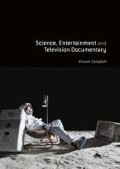Abstract
Campbell critically analyses television programmes on subject areas on the margins of science but which nonetheless are highly prominent on factual television channels, dealing with pseudoscientific topics such as ufology, parapsychology and cryptozoology. Despite being ‘for entertainment purposes only’ the chapter shows how programmes on pseudoscience and popular beliefs regularly draw on the ‘trappings of science’ and the techniques of documentary and factual entertainment to try and construct persuasive claims to the real. Campbell argues that they draw less heavily on subjunctive documentary techniques like CGI, developing their own techniques for making claims to serious investigation of popular beliefs like the use of night-vision cameras. Campbell concludes that their strategies and prominence on factual television channels represent the real risks to television science.
Access this chapter
Tax calculation will be finalised at checkout
Purchases are for personal use only
References
Brewer, P. R. (2012). The trappings of science: Media messages, scientific authority, and beliefs about paranormal investigators. Science Communication, 35(3), 311–333.
Brown, D. (2006). Tricks of the mind. London: Transworld Publishers.
Campbell, V. (2000). “You either believe it or you don’t …”: Television documentary and pseudo-science. In J. Izod & R. Kilborn (Eds.), From Grierson to the Docu-soap. Luton: University of Luton Press.
Campbell, V. (2006). Science, public relations, and the media: Problems of knowledge and interpretation. In J. L’Etang & M. Pieczka (Eds.), Public relations: Critical debates and contemporary problems. Mahwah: Lawrence Erlbaum Associates.
Corner, J. (1996). The art of record: A critical introduction to documentary. Manchester: Manchester University Press.
Cox, B. (2010, December 1). Science—A challenge to TV orthodoxy. Huw Wheldon lecture 2010. BBC, broadcast.
Cross, A. (2004). The flexibility of scientific rhetoric: A case study of UFO researchers. Qualitative Sociology, 27(1), 3–34.
Dolby, R. G. A. (1979). Reflections on deviant science. In R. Wallis (Ed.), On the margins of science: The social construction of rejected knowledge. Keele: University of Keele Press.
Fagan, G. G. (Ed.). (2006). Archaeological fantasies: How pseudoarchaeology misrepresents the past and misleads the public. London: Routledge.
Fara, P. (2009). Science: A four thousand year history. Oxford: Oxford University Press.
Gilovich, T. (1991). How we know what isn’t so: The fallibility of human reason in everyday life. New York: The Free Press.
Goode, E. (2013). Paranormalism and pseudoscience as deviance. In M. Pigliucci & M. Boudry (Eds.), Philosophy of pseudoscience: Reconsidering the demarcation problem. Chicago: Chicago University Press.
Hansson, S. O. (2013). Defining science and pseudoscience. In M. Pigliucci & M. Boudry (Eds.), Philosophy of pseudoscience: Reconsidering the demarcation problem. Chicago: Chicago University Press.
Hansson, S. O. (2015). Science and pseudo-science. In E. N. Zalta (Ed.), The Stanford encyclopedia of philosophy, Spring 2015 Edition. http://plato.stanford.edu/archives/spr2015/entries/pseudo-science/. Accessed 4 June 2015.
Hill, A. (2011). Paranormal media: Audiences, spirits and magic in popular culture. London: Routledge.
Holt, N. J., Simmonds-Moore, C., Luke, D., & French, C. C. (2012). Anomalistic psychology. Basingstoke: Palgrave Macmillan.
Kovacs, L. (2006). The haunted screen: Ghosts in literature and film. London: McFarland & Company.
Koven, M. J. (2007). Most haunted and the convergence of traditional belief and popular television. Folklore, 118(2), 183–202.
Kuhn, T. S. (1996). The structure of scientific revolutions (3rd ed.). Chicago: University of Chicago Press.
Leeder, M. (2013). Ghostwatch and the haunting of media. Horror Studies, 4(2), 173–186.
McGuire, A., & Buchbinder, D. (2010). The forensic gothic: Knowledge, the supernatural, and the psychic detective. Canadian Review of American Studies, 40(3), 289–307.
Metz, A. M. (2008). A fantasy made real: The evolution of the subjunctive documentary on US cable science channels. Television and New Media, 9(1), 333–348.
Moye, D. (2014, April 17). “Cell Block Psychic” TV show is “Abhorrent” to those who work with victims. Huffington Post. http://www.huffingtonpost.com/2014/04/17/cell-block-psychic_n_5160303.html. Accessed 17 June 2015.
Nichols, B. (2010). Introduction to documentary (2nd ed.). Bloomington: Indiana University Press.
Philips, M. (2008). The undercover philosopher: A guide to detecting shams, lies and delusions. Oxford: Oneworld.
Pigliucci, M., & Boudry, M. (Eds.). (2013). Philosophy of pseudoscience: Reconsidering the demarcation problem. Chicago: Chicago University Press.
Richman, H., & Bell, C. (2012). Paranormal beliefs then and now. North American Journal of Psychology, 14(1), 197–206.
Ruffles, T. (2004). Ghost images: Cinema of the afterlife. London: McFarland & Company.
Shermer, M. (1997). Why people believe weird things: Pseudoscience, superstition, and other confusions of our time. New York: W.H. Freeman and Company.
Sokal, A. D. (2006). Pseudoscience and postmodernism: Antagonists or fellow travellers? In G. G. Fagan (Ed.), Archaeological fantasies: How pseudoarchaeology misrepresents the past and misleads the public. London: Routledge.
Steward, T., & Zborowski, J. (2014). (G)hosting television: Ghostwatch and its medium. Journal of British Cinema and Television, 11(2–3), 189–212.
Switek, B. (2012, July 31). Mermaids embodies the rotting carcass of science TV. Wired. http://www.wired.com/2012/05/mermaids-embodies-the-rotting-carcass-of-science-tv/. Accessed 28 July 2015.
Wiseman, R. (2011). Paranormality: Why we see what isn’t there. London: Pan Macmillan.
Wolf, M. J. P. (1999). Subjunctive documentary: Computer imaging and simulation. In J. M. Gaines & M. Renov (Eds.), Collecting visible evidence. Minneapolis: University of Minnesota Press.
Author information
Authors and Affiliations
Copyright information
© 2016 The Editor(s) (if applicable) and The Author(s)
About this chapter
Cite this chapter
Campbell, V. (2016). Pseudoscience and Popular Beliefs. In: Science, Entertainment and Television Documentary. Palgrave Macmillan, London. https://doi.org/10.1057/978-1-137-38538-3_7
Download citation
DOI: https://doi.org/10.1057/978-1-137-38538-3_7
Published:
Publisher Name: Palgrave Macmillan, London
Print ISBN: 978-1-137-38537-6
Online ISBN: 978-1-137-38538-3
eBook Packages: Literature, Cultural and Media StudiesLiterature, Cultural and Media Studies (R0)

